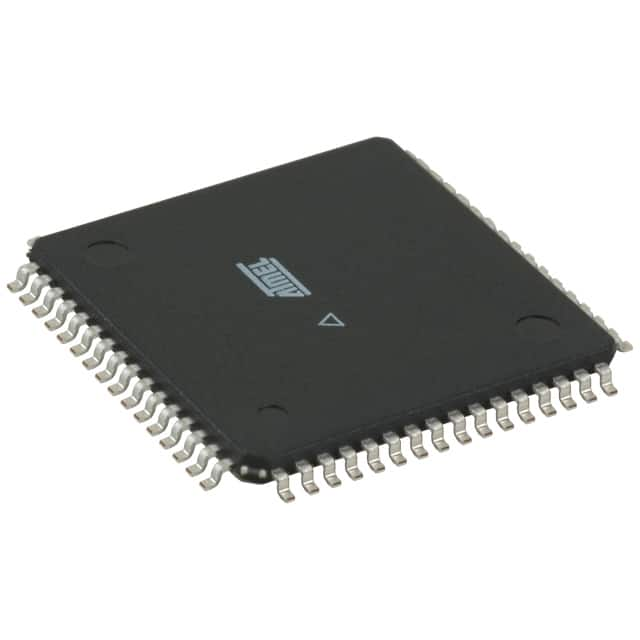Xem thông số kỹ thuật để biết chi tiết sản phẩm.

ATMEGA64-16AC
Product Overview
Category
ATMEGA64-16AC belongs to the category of microcontrollers.
Use
It is commonly used in various electronic applications that require a microcontroller for processing and controlling functions.
Characteristics
- High-performance microcontroller with advanced features
- Low power consumption
- Wide operating voltage range
- Large memory capacity
- Versatile input/output options
- Robust and reliable performance
Package
ATMEGA64-16AC is available in a compact and durable package, suitable for integration into different electronic devices.
Essence
The essence of ATMEGA64-16AC lies in its ability to provide efficient and precise control over various electronic systems.
Packaging/Quantity
ATMEGA64-16AC is typically packaged individually and is available in varying quantities depending on the manufacturer's specifications.
Specifications
- Microcontroller Architecture: AVR
- Operating Voltage: 2.7V - 5.5V
- Flash Memory: 64KB
- RAM: 4KB
- EEPROM: 2KB
- Number of Pins: 64
- Clock Speed: 16MHz
- Communication Interfaces: UART, SPI, I2C
- Analog-to-Digital Converter (ADC): 8 channels, 10-bit resolution
- Timers/Counters: 3 timers/counters
Detailed Pin Configuration
The pin configuration of ATMEGA64-16AC is as follows:
- VCC
- GND
- Port A0
- Port A1
- Port A2
- Port A3
- Port A4
- Port A5
- Port A6
- Port A7
- Port C0
- Port C1
- Port C2
- Port C3
- Port C4
- Port C5
- Port C6
- Port C7
- Port D0
- Port D1
- Port D2
- Port D3
- Port D4
- Port D5
- Port D6
- Port D7
- Port B0
- Port B1
- Port B2
- Port B3
- Port B4
- Port B5
- Port B6
- Port B7
- Reset
- XTAL1
- XTAL2
- AVCC
- AREF
- GND
Functional Features
- High-speed processing capabilities
- Multiple communication interfaces for data exchange
- Flexible input/output options for connecting external devices
- Built-in analog-to-digital converter for sensor interfacing
- Timers/counters for precise timing and event management
- Interrupt handling for efficient multitasking
- Power-saving modes for low-power applications
Advantages and Disadvantages
Advantages
- Powerful and versatile microcontroller
- Wide operating voltage range allows compatibility with various power sources
- Ample memory capacity for storing program code and data
- Robust performance ensures reliable operation in demanding environments
- Extensive input/output options enable connectivity with diverse peripherals
Disadvantages
- Relatively complex programming compared to simpler microcontrollers
- Higher cost compared to basic microcontrollers with limited features
- Steeper learning curve for beginners due to advanced functionalities
Working Principles
ATMEGA64-16AC operates based on the AVR architecture, utilizing a combination of hardware and software to execute programmed instructions. It follows a fetch-decode-execute cycle, where instructions are fetched from memory, decoded, and then executed by the microcontroller. The input/output pins, timers/counters, and communication interfaces are utilized to interact with external devices and perform various tasks as per the program's logic.
Detailed Application Field Plans
ATMEGA64-16AC finds applications in a wide range of fields, including but not limited to: - Industrial automation - Robotics - Home automation systems - Automotive electronics - Consumer electronics - Medical devices - Internet of Things (IoT) applications
Detailed and Complete Alternative Models
Some alternative models to ATMEGA64-16AC that offer similar functionalities include: - ATMEGA128-16AU - PIC18F4520 - STM32F103C8T6 - MSP430G2553
These alternatives can be considered based on specific project requirements, cost considerations, and compatibility with existing systems.
Word count: 536 words
Liệt kê 10 câu hỏi và câu trả lời thường gặp liên quan đến ứng dụng ATMEGA64-16AC trong giải pháp kỹ thuật
Sure! Here are 10 common questions and answers related to the application of ATMEGA64-16AC in technical solutions:
Q: What is the ATMEGA64-16AC?
A: The ATMEGA64-16AC is a microcontroller from Atmel, based on the AVR architecture.Q: What is the operating voltage range of ATMEGA64-16AC?
A: The operating voltage range is typically between 2.7V and 5.5V.Q: How much flash memory does ATMEGA64-16AC have?
A: It has 64KB of flash memory for program storage.Q: Can I use ATMEGA64-16AC for real-time applications?
A: Yes, ATMEGA64-16AC can be used for real-time applications as it has a built-in real-time counter (RTC).Q: Does ATMEGA64-16AC support analog inputs?
A: Yes, it has 8 analog input channels with a 10-bit resolution ADC.Q: Can I interface ATMEGA64-16AC with other devices?
A: Yes, it has multiple communication interfaces like UART, SPI, and I2C for interfacing with other devices.Q: What is the maximum clock frequency of ATMEGA64-16AC?
A: The maximum clock frequency is 16MHz.Q: Can I use ATMEGA64-16AC for low-power applications?
A: Yes, it has various power-saving modes that make it suitable for low-power applications.Q: Is ATMEGA64-16AC suitable for industrial applications?
A: Yes, it is designed to operate in harsh environments and can withstand industrial temperature ranges.Q: Are there any development tools available for ATMEGA64-16AC?
A: Yes, Atmel provides a range of development tools like compilers, debuggers, and programmers specifically for ATMEGA64-16AC.
Please note that these answers are general and may vary depending on the specific requirements and implementation of the technical solution.

